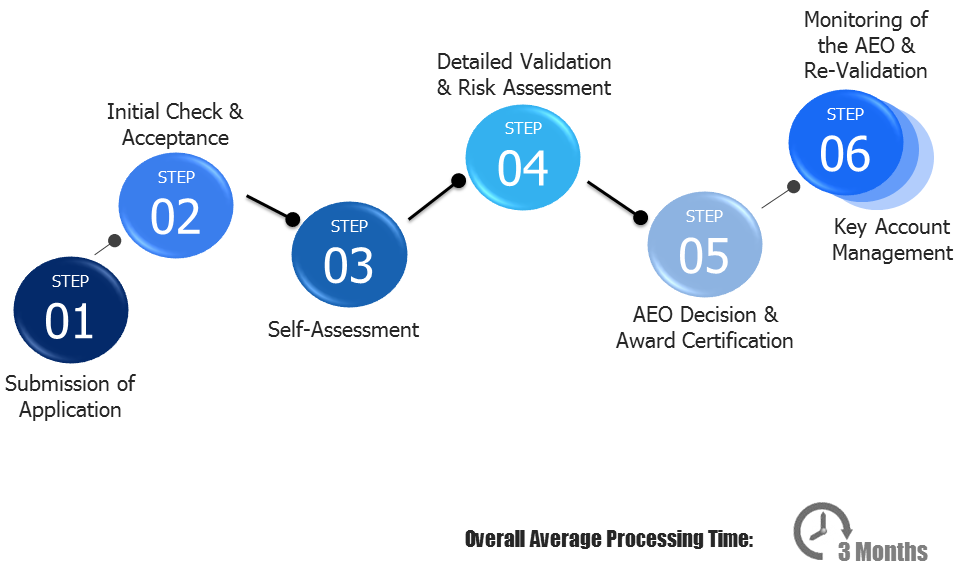Authorization Process
Following is the high-level six step process providing an overview of the overall AEO program:

The AEO Authorization process consists of a number of sub-processes:
- AEO Application Process;
- AEO Validation Process; and
- AEO Certification Process.
AEO Application Process :
The application process is the initial process in the AEO Authorization process and is initiated by the AEO applicant that applies for AEO status. Dubai Customs will then validate the completeness of the application as well as performing validation on the eligibility of the applicant.
The process ends either with an approved application, which then can continue to the validation sub-process, or with a denied application. In both cases the AEO applicant is advised and informed of the outcome.
AEO Validation Process :
The AEO validation process aims to validate that the applicant is eligible for AEO status. This is performed using three parts or sub-processes:
- Part 1 – Self Assessment Questionnaire (SAQ)
- Part 2 – Risk Assessment
- Part 3 – Validation
Self Assessment Questionnaire (SAQ)
The first part of the AEO validation process is the SAQ-phase. The applicant will be presented to and obliged to analyze, complete and submit a SAQ, tailor-made for the specific type of business the applicant is involved in. The AEO validation team assigned composes the tailored SAQ that is appropriate for the applicant.
In a meeting with the applicant, the possible facilitation benefits and their advantages will be explained as well as the business’s requirements and how to manage the SAQ. Information will be collected to consider which facilitation/benefits are most appropriate for the applicant and its activities. This initial step should provide good insight into the applicant’s supply chain activities.
The following subjects should be taken into account:
• The role of the business in the supply chain;
• Type of goods;
• Specific aspects of valuation;
• Classification;
• Origin of the goods;
• Security issues;
• Other regulatory requirements and,
• Reliability of the business’s (financial and logistic) accounting system
-Risk Assessment
After the SAQ is completed, validation team collects and assesses all available and relevant information, including intelligence information that is provided by the AEO Intelligence. This is base for the initial risk assessment. Risk assessment is necessary to find out the strengths and the weaknesses of the AEO applicant and all the areas to be covered by the validation process.
-Validation
After approval from the AEO Manager, the validation is initiated. During the validation assignment,information is gathered from various sources and analyzed. Site visits are performed in order for the AEO validators to study and validate the processes, systems and the premises of the AEO applicant.
- Collect Business Process and System Information
- Systems Verification
- Gather Understanding on Applicant’s internal monitoring and control
- Updating risk assessment
- Discussing and reporting
- Finishing the validation
Management and Monitoring :
The Management and Monitoring process consists of a number of sub-processes:
- Key Account Management Process;
- Monitoring and Evaluation Process
- Re-validation Process
Key Account Management Process;
Key Account Manager (KAM) performs the following:
- Day-to-day availability to respond to questions;
- Handling the exchange of information and reports with the AEO client;
- Arranging meetings and visits, ensuring good governance;
- Pro-actively supporting the AEO client with information about upcoming changes that potentially can have an impact on compliance and service levels, variations in current licenses and authorizations as well as the AEO status;
- Building networks with key institutions within and outside the own agency to be able to help the business receiving the correct information and thus foster compliance.
Monitoring and Evaluation Process
Continuous monitoring and evaluation process is the first part of the process. This is an essential part of the management of AEOs and significant efforts must be put in to this process
RE-Validation Process
The purpose of the re-validation process is to validate and ensure that the AEO is compliant with the AEO criteria defined by DC. Re-validation can be planned or initiated from the monitoring and management process, in case any new risks or deviations are identified. In either way, the scope of the re-validation can be full, in a similar manner as validation, or partly where focus is given on specific areas.
The re-validation involves the same process, reports and governance as defined in the validation process, even though the scope will vary.
The Re-validation process is following the exact same steps as the validation process specifications,except for the SAQ-phase, and includes the following two sub-processes:
- Part 1 – Risk Assessment
- Part 2 – Re-validation
AEO Certification Process :
When the decision has been made by the AEO Management that certification is possible, a dedicated AEO Key Account Manager (KAM) is assigned and the KAM issues the certificate and the certification details are entered in the CMS/ECR. It has to be taken into consideration, with regard to the compliance management strategy, how and by whom the certificate will be awarded. The certificate is a compliance motivator. It stimulates the mutual trust and it stipulates that their AEO status is not a free benefit.
In addition,
- Specific Memorandum of Understanding (MoU) are developed and signed;
- The certificate is officially handed over to the AEO applicant at a certification ceremony;
